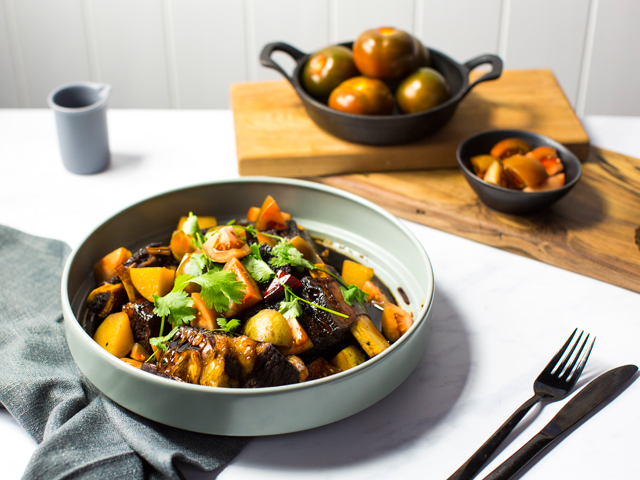Beef Ribs In Kecap Manis, Ginger and Kumato

This beef rib dish is full of flavour. Kumato® originated from Europe and is a mix of wild and traditional tomato varieties. Choose ripe Kumato® tomatoes that are a deep brown and turning dark red to really elevate this dish. The balance of acidity and sweetness works particularly well against the umami-tasting ingredients.
Serves: 4
Ingredients
4 beef short ribs
3 tbs vegetable oil (for the rub)
4 shallots, diced
4 garlic cloves, crushed
4cm piece of ginger, peeled and diced
1 red chilli, diced
2 stalks lemongrass, chopped (white part only)
¼ cup kecap manis
2 tbs soy sauce
1L chicken stock (plus extra if required)
8 chat potatoes
5 Kumato® tomatoes diced
Juice of 2 limes
2 cups basmati rice
½ cup coriander leaves
Method
Season the beef ribs with salt and pepper and rub with 2tbs oil. Heat the remaining oil in a large deep-frying pan and brown the ribs. Remove the ribs and keep the oil hot.
Sauté the shallots, garlic, ginger, chilli and lemongrass in the oil over a medium heat for 3 minutes or until fragrant.
Return the ribs to the pan and add the kecap manis and soy sauce. Bring to a simmer and add the chicken stock. Simmer and cover for 2½ hours, checking every 20 minutes. Be sure to add more stock as required to stop the ribs from sticking.
Add the potatoes and simmer uncovered for a further 15 minutes. Add 4 x diced Kumato® tomatoes to the pan and simmer for a further 2 minutes. Add the lime juice.
Ben Milbourne's Kumato® Masterclass
Kumato® tomatoes are a foodie favourite with their bold flavour and striking dark colour elevating summer dishes.
Originating in Europe, this glasshouse grown tomato is a natural mix of wild and traditional tomato varieties.
To keep up with their popularity and the demand from loyal foodie fans, Kumato® tomatoes are now grown 12 months of the year and peak in November, providing an abundance of Kumato® tomatoes just in time for festive celebrations.
Celebrity chef Ben Milbourne said this deliciously distinct tomato could be eaten at any stage of ripeness.
"Within three to five days, a Kumato® ripens from flavourful and bright green, to sweet and deep brown/red when fully ripe," said the former MasterChef contestant, cook book author and host of Food Lab.
"Each stage of ripeness brings with it unique textures and tastes – all of which can be enjoyed and provide fantastic opportunities to experiment with delicious flavour pairings."
Ben Milbourne shares his masterclass tips on Kumato® tomatoes:
Simplicity - The Kumato® has such a fantastic flavour on its own that it's best to keep any dressing simple and not too overpowering. My favourite is to dress Kumato® tomatoes with regular light olive oil and a little sprinkle of sea salt. A bolder extra virgin olive oil is not necessary.
Balance - The great thing about the Kumato® is that it has a slight acidity as well as sweetness, which means cooking with them is about balancing flavours. For a perfectly balanced dish, its best to pair Kumato® with ingredients that have umami tastes like haloumi cheese or a nice salty feta.
Texture – When Kumato® tomatoes are in their earlier stages of ripeness, (brown on the bottom and green on top) they are full of flavour and have a wonderful firm texture that holds together well. It makes them ideal for cutting and salads.
Sweetness – A ripe Kumato® (deep brown turning to a dark red) is perfect for cooking. This is also when they are at their sweetest and are delicious for roasting or cooking down into a decadent, rich pasta sauce.
Flavour – To retain its deliciously sweet flavour, it's always best to store Kumato® tomatoes at room temperature on the kitchen bench. Refrigerating a Kumato® will affect the natural sugars and it won't be as sweet.
Kumato® tomatoes are exclusive to Perfection Fresh and are grown in glasshouses in South Australia and Victoria. They are available as full-sized tomatoes and grape varieties. Kumato® tomatoes are sold at supermarkets and greengrocers nationally.
Recipe Credit: Created by Ben Milbourne for Perfection Fresh
MORE



